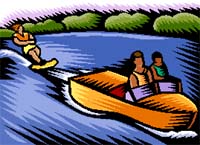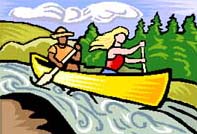|
Recreational Uses in the Watershed :Recreation is a very important part of the lives of many people in the Puget Sound Region. Because the area is surrounded by water, many people enjoy boating, fishing and even flying around in seaplanes that land on the lakes and sound. To increase navigation to Seattle, a thoroughfare was installed between Lake Washington and the Puget Sound in 1916. In this thoroughfare, a set of locks was built. The path of the Cedar River was diverted into Lake Washington to raise the level of Lake Union and supply the fresh water necessary to move boats up and down between the lake and the sound. Today, if one goes to visit the locks, it becomes very apparent that the primary users of the locks are recreational boat users. Those who use Lake Washington for power boating, fishing or landing or taking off in seaplanes all may be creating disturbances in the patterns and success rate of anandromous fish. Those using the locks have a vested interest in keeping them operating in spite of the fact that they pose a substantial obstacle to anandromous fish. One form of recreation that has already been halted is any use of the Cedar Watershed area for anything except guided, educational tours. This area is not open to rafting, hiking, kayaking, camping, fishing, mountain biking or any other sort of recreation. By doing so, the city can be assured that they have done the most possible in the watershed to prevent people for polluting the city’s water source or inflicting harm to the fish in their breeding grounds. However, this does not address the potential harm that may be inflicted upon fish lower in the system. Biologists have established minimum levels of fish that must be allowed to spawn to insure that the stock’s production is sufficient to insure the survival of the species. If additional fish are allowed to be harvested, an additional number of fish must be allowed to return to spawn to insure this supply is met. For sockeye, is estimated that less than 1˝ fish return for each parent spawner in Lake Washington ( http://www.wa.gov/wdfw/fish/sockeye/fishing.htm). Each year, fish managers must count the fish that pass through the locks and determine if there are sufficient runs to allow a fishing season to open and if so, what the catch limit should be. The catch is limited to certain areas of Lake Washington and to fish of a certain size. Because generally each species of fish runs at different times of the year, it is easier to prevent more endangered species of fish from being caught. Indeed, in 1982, checks were made on 19 of 32 time periods and only one Chinook was observed. No data was available to indicate if studies have been performed to determine what affect recreational boating or seaplanes may have on fish populations.STAKEHOLDERS: FISH VERSUS RECREATION
|

